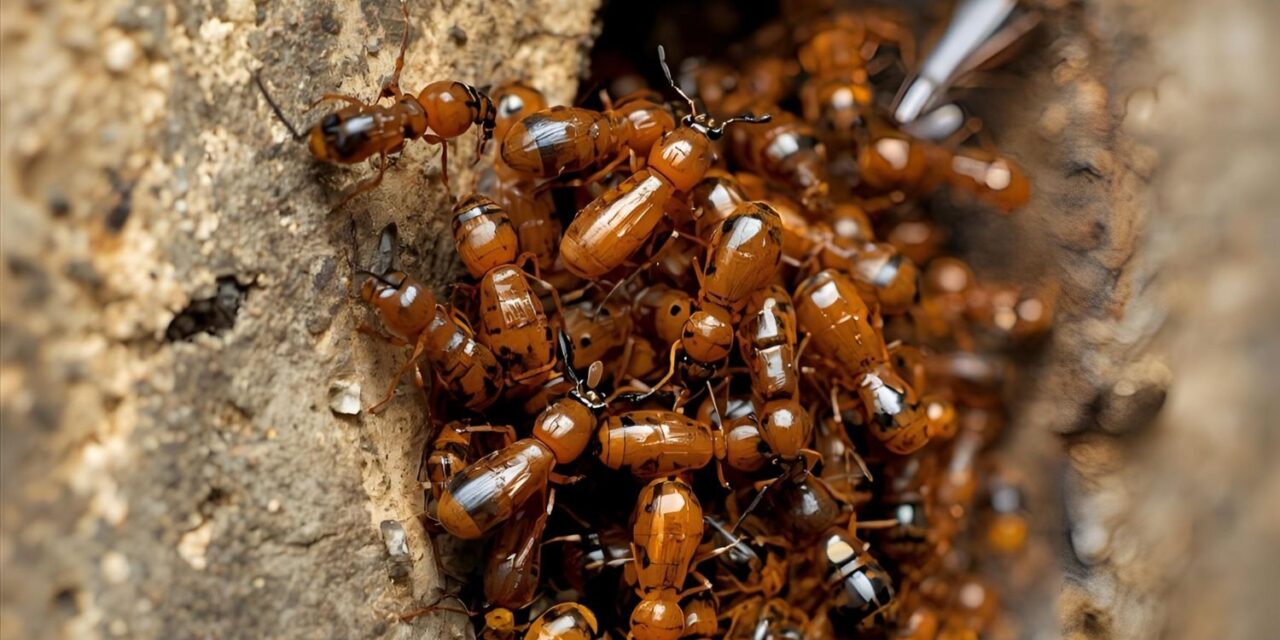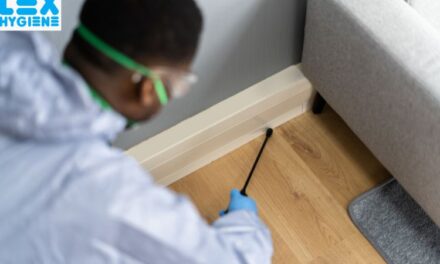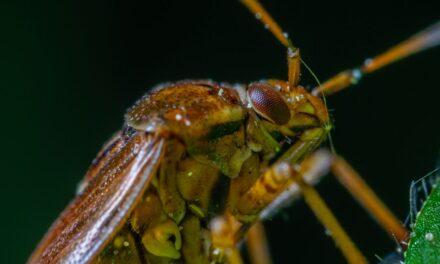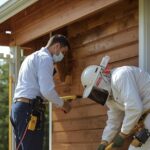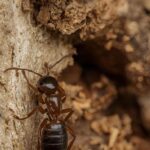Estimated reading time: 9 minutes
Key Takeaways
- Termites are “silent destroyers” capable of causing extensive hidden damage to homes.
- Early detection of an infestation is paramount to prevent significant structural damage and save on costly repairs.
- Key signs of termite infestation include mud tubes, discarded wings, frass (droppings), and visible wood damage.
- Specific inspection methods, such as tapping walls and checking baseboards, are crucial for identifying hidden termite activity.
- Upon discovering any signs, do not disturb the termites; immediately contact a professional pest control service for effective treatment.
Table of Contents
- Identifying the Signs of Termite Infestation: Your Essential Guide to Early Detection
- Key Takeaways
- The Urgency of Early Detection: Why Catching an Early Termite Infestation Matters
- Understanding the Common Signs of Termites
- Focused Inspection: How to Check Termites in Walls
- What to Do After Spotting Signs of Termite Infestation
- Conclusion
- Frequently Asked Questions
Termites are often called “silent destroyers” for a very good reason. These tiny pests can cause huge damage to your home without you even knowing they are there. They work quietly, munching away at wooden structures from the inside out. This hidden work makes them a serious threat to any homeowner.
That’s why recognizing the signs of termite infestation early is so important. Catching these wood-destroying insects before they cause too much harm can save you a lot of trouble and money. Early detection helps prevent extensive damage to your home. It also saves homeowners substantial repair costs that can quickly add up.
This guide is here to help you. We will walk you through what to look for so you can understand how to spot an early termite infestation. We’ll also dive into specific methods for how to check termites in walls, which are often a prime target for these destructive pests. By the end, you’ll be much better at protecting your most important investment.
The Urgency of Early Detection: Why Catching an Early Termite Infestation Matters
Imagine a hidden enemy slowly eating away at the very bones of your home. That’s what termites do. If left unchecked, these tiny creatures cause significant financial and structural damage. Their presence can be a nightmare for any property owner.
Each year, these destructive pests are responsible for billions of dollars in property damage across the United States. This damage is often not covered by homeowner’s insurance. This means you could be left with a huge bill if an infestation gets out of hand. [Source: National Pest Management Association]
An early termite infestation might involve only a few small colonies. But don’t let their size fool you. These wood-munching pests can quickly expand. A small group can grow into a massive colony that damages your home day and night. The longer an infestation goes unnoticed, the more widespread and severe the destruction becomes.
Expanded colonies can compromise the structural integrity of a home’s wooden components. This includes important parts like foundations, support beams, and even furniture. This structural harm can make your home unsafe and greatly reduce its value. It’s like having the foundational pieces of a puzzle slowly disappear.
Identifying an early termite infestation can save homeowners thousands of dollars in repair costs. When you find them early, pest control experts can use targeted treatments. These treatments are less extensive and much more effective. They stop the problem before it becomes a widespread disaster. Thinking ahead means protecting your home and your wallet from these voracious wood-eaters.
Understanding the Common Signs of Termites
Protecting your home starts with knowing what to look for. Recognizing the general categories of indicators is the first step in spotting these silent destroyers. Keep an eye out for these key signs of termites to catch an infestation before it spirals out of control.
A. Mud Tubes (Shelter Tubes)
One of the most obvious and definitive signs of termites is the presence of mud tubes. These are pencil-sized tunnels made of soil, wood, and termite saliva. They are built by subterranean termites, a common type of termite that lives underground.
These shelter tubes serve a critical purpose. They protect termites from predators, like ants, and from dry environments as they travel. They act like highways, allowing termites to move safely between their underground colony and their food source – which is often your home’s wooden structure.
You should look for mud tubes in specific places. Check on exterior and interior foundation walls. Look in crawl spaces, which are often damp and dark. Inspect floor joists and around pipes. These are all common pathways for these destructive insects to enter and move through your home. If you find these tell-tale tubes, it’s a strong indicator of active termite presence.
B. Discarded Wings
Often, the first visible signs of termites that homeowners notice are discarded wings. Finding these tiny, delicate wings often means that a termite “swarm” has happened.
Termite swarmers are winged reproductive termites. They emerge from mature colonies to establish new ones, especially during warm, humid weather or after rain. They fly out, mate, and then shed their wings as they prepare to start a new colony.
You’ll usually find small piles of these shed wings near windows, doors, or light fixtures. They might also gather in spiderwebs or around vents. Termite wings are generally uniform in size, meaning all four wings on a single swarmer are about the same length. This helps you tell them apart from flying ants, which have two pairs of wings of unequal length (the front wings are longer than the back ones). Spotting these wings is a clear indicator of an early termite infestation or at least that a colony is active nearby and expanding.
C. Frass (Termite Droppings)
Another key indicator among the signs of termites is frass, which are termite droppings. This is a tell-tale sign of drywood termite activity. It’s important to understand the difference between drywood termites and subterranean termites when looking for frass.
Unlike subterranean termites, drywood termites do not need contact with soil. They nest directly within the wood they consume. As they tunnel through wooden structures, they create small “kick-out holes” through which they expel their waste. This waste is the frass.
Frass looks like tiny, hard, hexagonal-shaped pellets. It often resembles sawdust or small grains of sand. The color of the frass can vary depending on the type of wood the termites have been eating. It might be light brown, dark brown, or even reddish. You’ll find frass accumulating in small piles on floors, windowsills, or furniture directly below infested wood. These little piles are a strong clue that drywood termites are actively destroying your home.
D. Damaged Wood
One of the most concerning signs of termites is the actual damage they inflict on wood. Termites eat wood from the inside out. This often leaves only a thin veneer of wood or paint on the surface. This habit makes initial detection very difficult, as the damage is hidden from plain sight.
Hollow Sounds
If you suspect termites, one way to check is to tap on wooden surfaces. Use the handle of a screwdriver or a small hammer and listen carefully. If the wood sounds hollow or papery when tapped, it’s a serious red flag. This hollow sound indicates that the wood-destroying insects have created extensive galleries or tunnels within the wood. The interior has been eaten away, leaving only an empty shell. This method is crucial when learning how to check termites in walls.
Blistered Wood or Peeling Paint
Subterranean termites need moisture to survive and thrive. As they tunnel through wood, they introduce moisture into it. This can cause the wood to appear blistered or cause paint to bubble or peel unevenly. These visual changes on surfaces might look like water damage, but in reality, they are signs of termites working beneath the surface. Don’t ignore these subtle changes in the appearance of your wood or painted surfaces.
Visible Galleries
In severe cases, the wood may become so extensively damaged that it crumbles easily. When this happens, it can reveal the intricate tunnels or galleries that termites have excavated. These tunnels are their pathways and living spaces. It’s interesting to note that subterranean termites often follow the grain of the wood when tunneling. Drywood termites, on the other hand, tend to tunnel across the grain. Seeing these damaged tunnels means a very advanced and serious infestation.
E. Clicking Noises
While less common to hear, some homeowners report faint clicking or rustling sounds coming from within walls or wooden structures. If your home is very quiet, you might just catch these subtle noises.
This sound is often attributed to soldier termites. Soldier termites bang their heads against tunnel walls. They do this as a warning signal to the rest of the colony when they feel disturbed or threatened. It’s a way for them to communicate danger. You might also be hearing the quiet but persistent sounds of worker termites chewing and munching through the wood. While not as common as other signs of termites, paying attention to unusual sounds in your home can sometimes provide an early termite infestation warning. These noises can sometimes give you a hint when learning how to check termites in walls.
Focused Inspection: How to Check Termites in Walls
Walls are a primary target for termites because they offer hidden pathways and abundant wood. However, termite damage within walls can be very well concealed. This makes a focused and careful inspection absolutely key to catching these pests early. Knowing how to check termites in walls is a vital skill for any homeowner.
A. Tapping Walls
One of the simplest yet most effective ways to look for hidden termite damage is by tapping on your walls.
- Method: Gently tap on wall surfaces, especially around baseboards, door frames, and areas suspected of moisture issues. You can use the handle of a screwdriver or a small hammer.
- Observation: Listen carefully for any change in the sound the wall makes.
- Interpretation: A solid, firm tap should be expected from healthy wood or drywall. If you hear a hollow, dull, or papery sound, it can indicate internal wood damage. This also suggests void spaces created by termites, which have eaten away the wood from the inside. This is one of the most practical signs of termites you can detect yourself.
B. Visual Cues on Walls
Your eyes are your first line of defense. Look closely for any subtle changes on your walls.
Subtle Mud Leads or Tubes
Beyond the obvious foundation mud tubes, look for thinner, more delicate mud trails directly on interior or exterior wall surfaces. These trails can sometimes appear as discolored streaks or faint lines, almost like dirt marks that shouldn’t be there. They are often smaller than the main mud tubes but serve the same purpose for subterranean termites.
Tiny Pinholes or Exit Holes
Inspect your walls for tiny, almost imperceptible holes. These are especially common in drywall, plaster, or wooden panels. Drywood termites create these small holes to expel their frass (droppings). Additionally, swarmers of both subterranean and drywood termites can create exit holes when they leave the colony to mate and establish new ones. Finding these small openings can be an important early termite infestation clue.
Bubbling, Peeling, or Blistering Paint/Wallpaper
This is a critical sign to watch for. Termites need moisture to survive. Their tunneling activity behind wall surfaces can cause moisture to build up. This trapped moisture then leads to the paint or wallpaper detaching, bubbling, or appearing water-damaged. This happens even when there’s no plumbing leak or other visible water source. If you see paint peeling that doesn’t seem to have a clear water-related cause, it could be one of the key signs of termites working in your walls. This indicates that these wood-destroying insects are present and causing hidden harm.
C. Baseboards and Door Frames
These wooden elements are often in direct contact with the floor and foundation. This makes them highly vulnerable entry points for termites.
- Inspection Points: Inspect your baseboards and door frames very closely. Look for any signs of termites such as mud trails, small holes, or any areas that appear warped, soft, or otherwise damaged. These areas are prime targets for subterranean termites moving up from the soil or drywood termites setting up shop.
- Detection: Advise gently pressing on these areas with your thumb. Feel for any softness or hollowness. If the wood gives under light pressure, it’s a strong indicator of internal damage. This can be caused by wood-boring insects, including termites. Learning how to check termites in walls includes paying close attention to these easily accessible wooden parts.
D. Probing Soft Spots
If you identify a visibly soft, spongy, or suspicious area on a wall or wooden trim, it’s time for a more direct check.
- Method: Cautiously and gently probe the area with a screwdriver or an awl. You don’t need to apply a lot of force.
- Interpretation: If the wood or drywall gives way easily or crumbles, it strongly suggests internal damage. This damage could be from termites or from wood rot. Termites chew through the cellulose in wood, creating weakened, hollowed-out sections.
- Caution: Exercise caution to avoid unnecessary damage if no clear signs of termites are present. Only probe areas that already show strong indicators of a problem. This careful probing is a precise way to figure out how to check termites in walls for hidden invaders.
What to Do After Spotting Signs of Termite Infestation
If you suspect or confirm signs of termite infestation in your home, immediate and appropriate action is absolutely essential. Don’t panic, but don’t delay either. Taking the right steps quickly can make a big difference in controlling the problem.
A. Do Not Disturb
This is perhaps the most crucial advice once signs of termite infestation are identified. It’s natural to want to poke, prod, or try to get rid of them yourself. However, it’s vital not to disturb the termites.
- Actions to Avoid: Specifically avoid poking at mud tubes, trying to spray them with household pesticides, or removing damaged wood. These actions might seem like a good idea, but they are counterproductive.
- Reason: Disturbing the colony can cause the termites to scatter. They might move to other, undiscovered parts of your home. This makes detection and effective treatment much more challenging for professionals. You want the experts to find the main colony, not have it disperse into multiple smaller, harder-to-find groups. By leaving them alone, you allow professionals to get a clearer picture of the full early termite infestation.
B. Immediate Action Steps
Your primary step should be to contact a professional pest control service as soon as possible. These experts are specifically trained to handle these destructive pests.
- Professional Expertise: Professionals possess the necessary expertise, specialized tools, and in-depth knowledge to handle termite issues. They will conduct a thorough inspection of your property. They can accurately identify the species of termite present, which is important because different termites require different treatments. They will also assess the true extent of the infestation, even in hidden areas. Based on this information, they will develop a customized, effective treatment plan tailored to your home’s specific needs. Calling them quickly ensures you are tackling the problem with the best resources available for your early termite infestation.
C. Avoid DIY Treatments
While many home improvement stores offer over-the-counter termite treatments, it’s crucial to understand their limitations.
- Ineffectiveness: Over-the-counter DIY termite treatments are often ineffective for treating an entire colony. They might kill a few individual termites you see, but they rarely reach the queen or the vast numbers of worker termites hidden deep within your walls or foundation. Termite colonies can be huge, sometimes numbering in the millions.
- Risk: Trying to treat termites yourself can even worsen the problem. By using ineffective treatments, you might disrupt the colony. This can cause the termites to disperse and create new, harder-to-find infestations in other parts of your home or even your neighbor’s property.
- Solution: Professional treatment is typically required for long-term control and complete eradication of signs of termites. Pest control companies use specialized chemicals and methods that are designed to eliminate the entire colony, not just the visible surface activity.
Conclusion
Vigilance and a proactive approach are truly your best defenses against the silent threat of termites. These tiny wood-destroying insects can cause massive problems if left unnoticed. Regularly inspecting your home and knowing the signs of termite infestation can be a game-changer.
By being aware and checking often, you can lead to the detection of an early termite infestation. This significantly reduces potential damage to your property and saves you a great deal of money in future repair costs. Protecting your home means staying one step ahead of these destructive pests.
By learning how to check termites in walls and recognizing other key indicators like mud tubes, discarded wings, frass, and damaged wood, you are better equipped to protect your most valuable asset. Don’t hesitate to take action. At the very first signs of termite infestation, contact a professional expert for a comprehensive inspection and effective treatment. Your home’s safety and your peace of mind are worth it.
Frequently Asked Questions
What are mud tubes, and what do they mean?
Mud tubes are pencil-sized tunnels made by subterranean termites from soil, wood, and saliva. They indicate active termite presence, serving as protected pathways for termites to travel between their underground colony and their food source (your home’s wooden structures). Finding them is a strong sign of infestation.
How can I differentiate between termite wings and ant wings?
Termite wings are generally uniform in size, meaning all four wings on a swarmer are roughly the same length. Flying ants, however, have two pairs of wings of unequal length, with the front wings typically longer than the back ones. Termite wings are also often found in piles after swarming, as they shed them.
Why shouldn’t I disturb termites if I find them?
Disturbing termites, such as poking mud tubes or applying DIY treatments, can cause them to scatter and move to other, undiscovered parts of your home. This makes it much harder for professionals to locate the main colony and apply effective, targeted treatments, potentially worsening the overall infestation.
Are DIY termite treatments effective?
Over-the-counter DIY termite treatments are rarely effective for complete colony eradication. They might kill visible termites but typically fail to reach the queen and the vast hidden network of the colony. Using them can also disrupt the colony, causing termites to disperse and create new infestations elsewhere, making professional treatment more challenging later.

